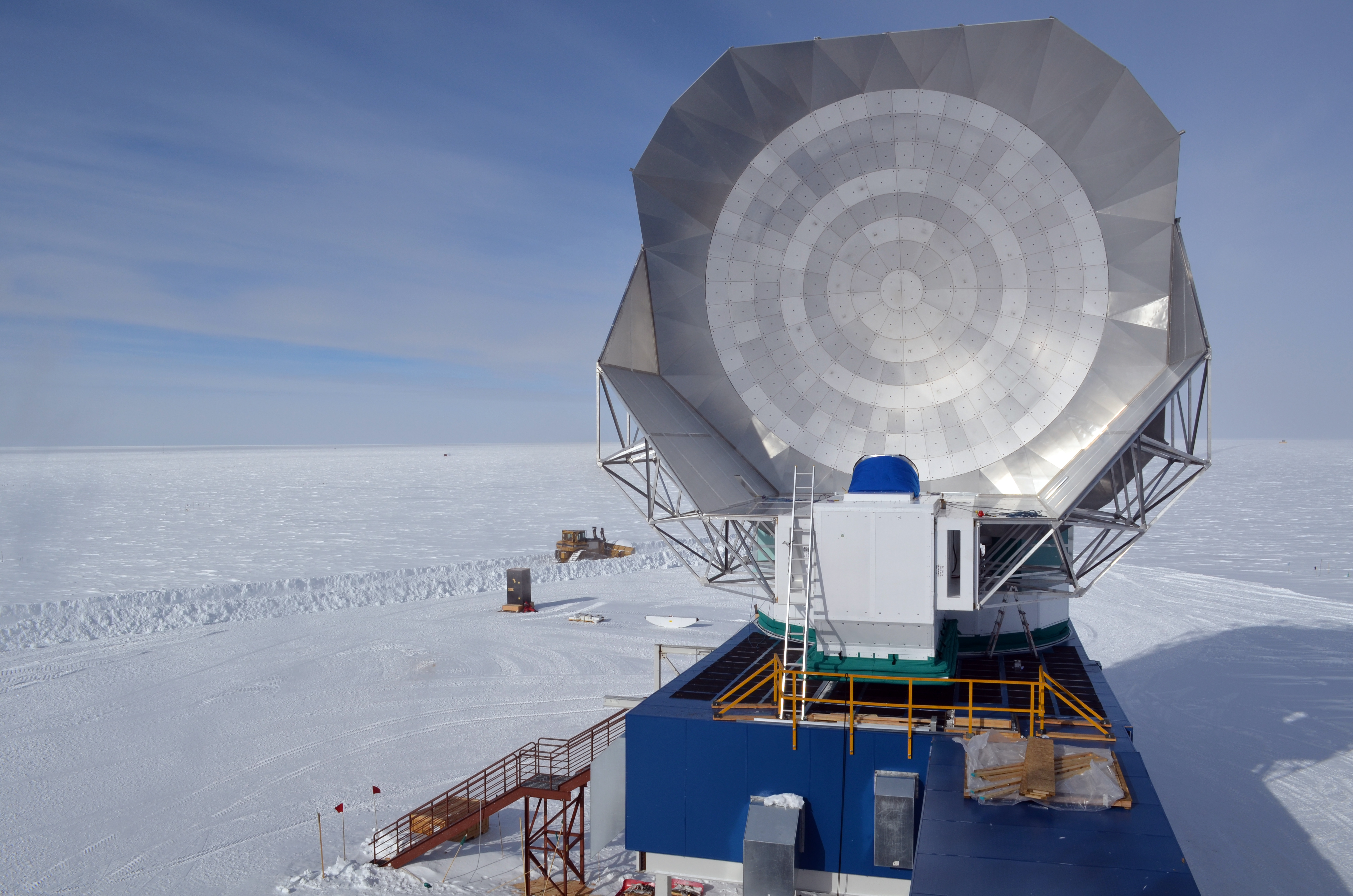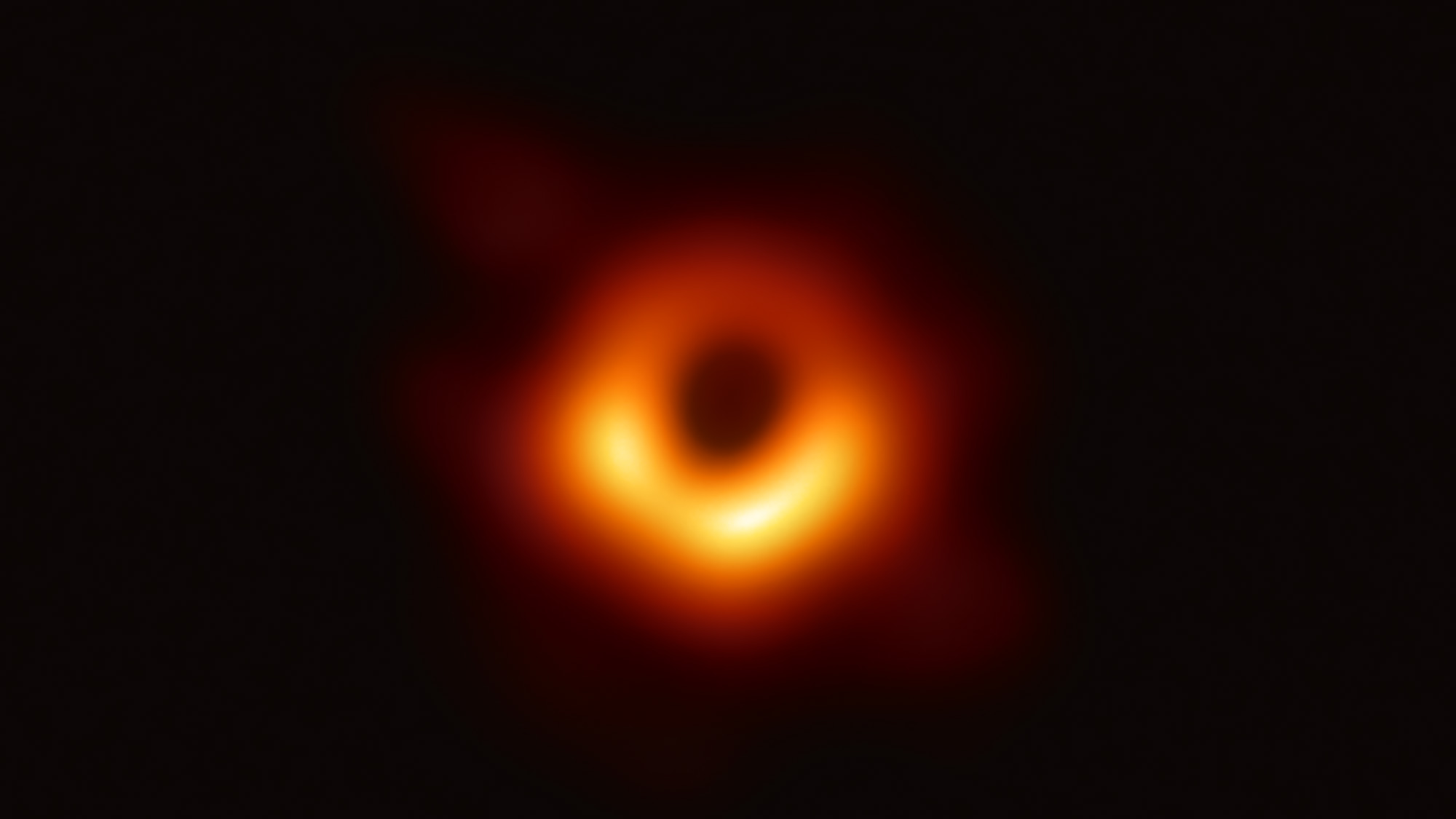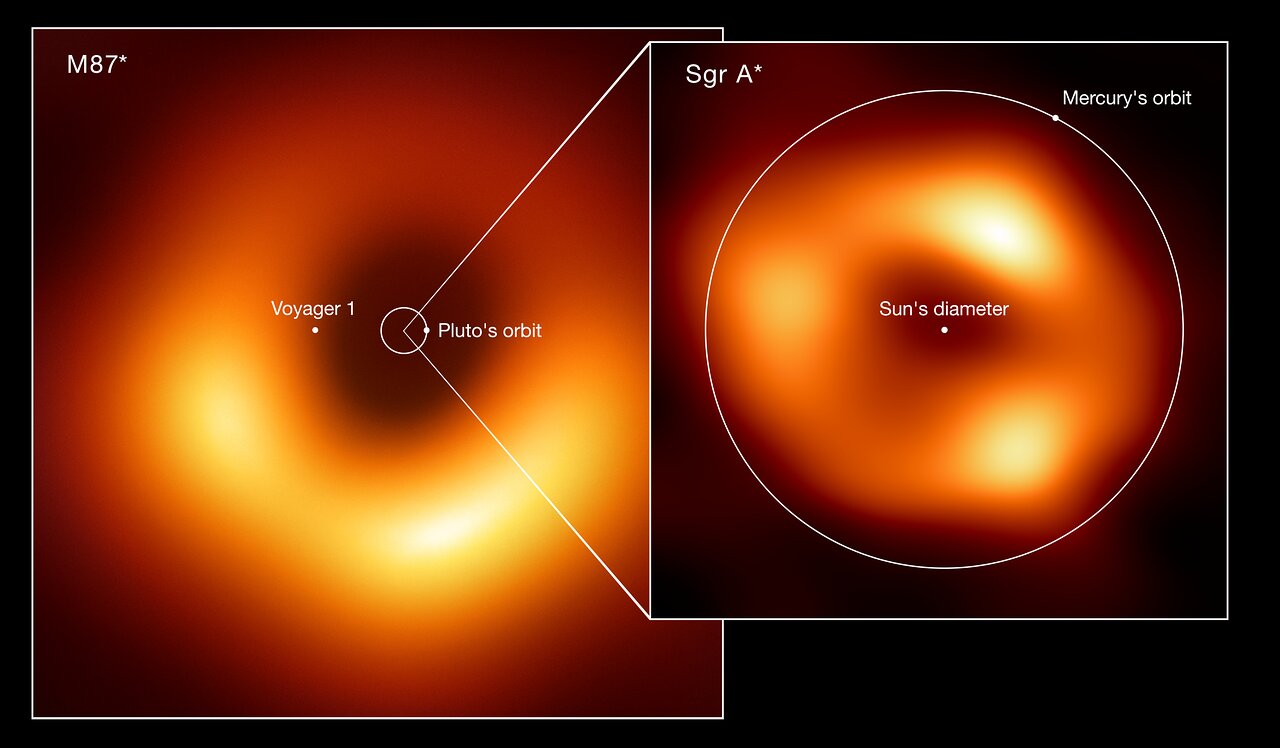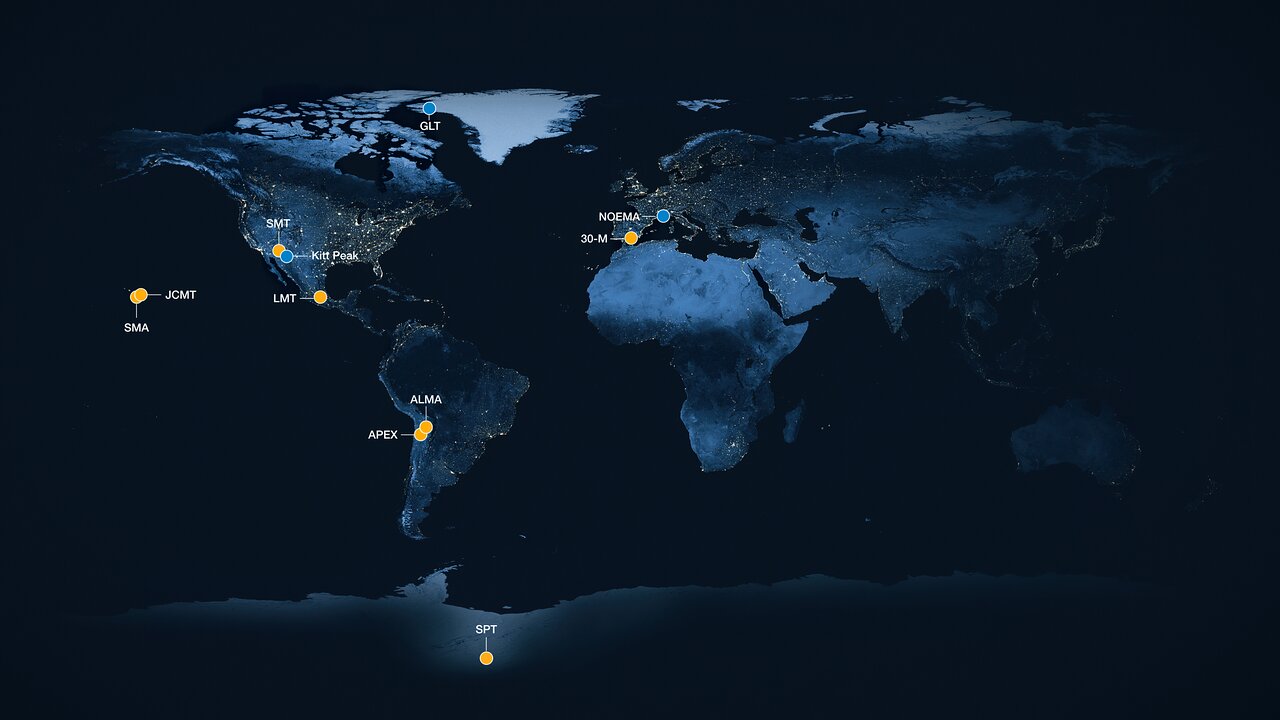Event Horizon Telescope: A complete guide
Introducing the black hole imaging global collaboration.

The Event Horizon Telescope (EHT) is a network of synchronized radio observatories around the world that combine as a single telescope with an aperture the size of Earth used to observe sources of radio light associated with black holes.
According to the Event Horizon Telescope Collaboration, this planet-sized telescope has an angular resolution comparable to the event horizons of black holes, the one-way light-trapping surface that is the boundary of a black hole the key to its success in observing black holes.
The event horizon represents the point at which not even light is fast enough to outrace the gravitational influence of a black hole, and as such is the "deepest" we ever hope to see into a black hole.
Related: The 10 biggest telescopes on Earth
Even imaging the immediate, violent, and turbulent environment around a black hole is no small feat, yet this is exactly what astronomers using the EHT have managed to do. In the process not only have they delivered stunning images of these cosmic titans, but these images have also managed to confirm Albert Einstein's theory of general relativity as the black holes and their surroundings appear almost exactly as this groundbreaking theory of gravity predicts.
How does the Event Horizon Telescope image black holes?
To be clear, the EHT can't image the black hole itself thanks to the light-trapping action of the event horizon.
A black hole is a region of spacetime that captures any incident light and thus emits no light. That means black holes are invisible in all forms of electromagnetic radiation we can currently detect, so imaging the black hole itself which lies beyond the event horizon outer boundary, is impossible.
Breaking space news, the latest updates on rocket launches, skywatching events and more!
The EHT collaboration explains that the EHT allows scientists to see the area of space immediately surrounding the black hole and the effects that the massive gravitational influence of the black hole has on this region.
Around some supermassive black holes is a disk of gas and dust that astronomers call an accretion disk because this material is gradually fed, or accreted, to the black hole. The tremendous gravitational influence on this material exerted by the black hole gives rise to violent conditions that cause the material to be super-heated and glow.
Radboud University researcher and chair of the EHT Science Council, Heino Falcke explained that if a black hole is immersed in this bright region then it should cast a shadow on this glowing gas. This shadow caused by the gravitational bending and capturing of light when imaged can reveal a great deal about the black hole that casts it including its mass and its size.
The EHT observes this phenomenon at a wavelength of 1.3 millimeters using a process called very-long-baseline interferometry (VLBI) achieving an angular resolution of 20 micro-arcseconds. The EHT Collaboration explains this is powerful enough to read a newspaper in New York from a sidewalk café in Paris!
It's no exaggeration to say, that by using this ability in 2019 the EHT was able to irrevocably shift the paradigm of astronomy and cosmology, and perhaps of science itself.
Event Horizon Telescope FAQs answered by an expert
We asked Michael Janssen, a postdoctoral researcher at the Max Planck Institute for Radio Astronomy in Bonn, Germany, a few questions about the black hole imaging Event Horizon Telescope.

Michael Janssen is a postdoctoral researcher at the Max Planck Institute for Radio Astronomy in Bonn, Germany who conducts research with the Event Horizon Telescope (EHT).
How does the Event Horizon Telescope work?
The EHT consists of several radio telescopes around the globe, which work together as an astronomical interferometer. Here, the resolution of the instrument is no longer given by the size of a single telescope, but by the distance between pairs of telescopes. Simply stated, we track the arrival times of radio waves emitted from the vicinity of an observed astronomical source (a black hole) at our telescopes at different locations on Earth. From the differences in arrival times, we can then reconstruct the structure of the observed source with sufficient resolution. In an analogy, one can view the EHT array as a single big incomplete virtual radio telescope, where the individual parts are given by the handful of telescopes in our array. Or as small shards of a big broken mirror.
What makes the Event Horizon Telescope special?
The EHT has telescopes around the globe and is therefore a "very long baseline interferometry" (VLBI) network. With the VLBI techniques, the highest resolution in astronomy can be achieved. While there are other VLBI arrays in the world (e.g., the Very Long Baseline Array and the European VLBI Array), the EHT is special, because the other networks observe radio waves with long (centimeters) wavelengths, while the EHT observes at much shorter (millimeter) wavelengths. The shorter the wavelength of the measured radio waves, the more difficult the data processing and calibration, but the better the resolution. This makes the EHT the only instrument on Earth that has a sufficient resolving power to directly image black holes. This resolving power would also be sufficient to see an apple on the moon.
How does the Event Horizon Telescope differ from other major telescopes such as the James Webb Space Telescope (JWST)?
The EHT is not a single telescope like the JWST, but an array of individual radio telescopes. JWST observes in the micrometer (near infrared) range with a resolution of about 0.1 arcsecond, where one arcsecond is 1/3600 of a degree. The EHT observes in the millimeter (radio) range with a resolution of 0.000025 arcseconds. So the EHT can see 4000 sharper than the JWST.
How has the EHT changed astronomy?
The EHT has taken the first direct pictures of black holes and thereby providing conclusive evidence for the existence of supermassive black holes. This achievement is highly complementary to the measured gravitational wave signals by LIGO/VIRGO of much smaller stellar-mass black holes. With the EHT images of two black holes, that are a million and a billion times more massive than our sun, we have successfully tested Einstein's general theory of relativity in an unprecedented environment and parameter space.
I would say that the EHT has also helped a great deal in popularizing astronomy and the amazing technique of VLBI. Did you know that the stability of the universal time standard is also measured with VLBI and that GPS only works when the effects of the general theory of relativity are taken into account?
What is the most impressive achievement of the EHT thus far?
We have imaged the supermassive black holes in the heart of our own galaxy and the center of the galaxies Messier 87, which is 53 million light-years away from Earth. In both cases, the images looked exactly as predicted by general relativity. So for both these extremely mysterious objects, which actually differ in their mass by three orders of magnitude, Einstein's 100-year-old theory still holds!
How does your work relate to the EHT?
I currently work at the Max Planck Institute for Radio Astronomy in Bonn, Germany. I contribute to several aspects of the EHT: I participate in the observations, where we gather the data at several radio telescopes around the world and I work on the scientific analysis. But my primary focus lies at the interface between the observations and the science, where we characterize and calibrate the data gathered at the telescopes. Here, we correct for imperfections in the surfaces of the dishes of our radio telescopes and filter out influences of the Earth's atmosphere on the recorded radio waves.
Imaging the supermassive black hole of M87
It was on April 10, 2019, that the EHT collaboration announced to the world that the EHT had captured the image of the supermassive black hole at the heart of the galaxy Messier 87 (M87).
This supermassive black hole, also known as M87*, is located 55 million light years away from Earth. With a mass equivalent to anywhere between 2.4 and 5 billion suns and a diameter of around 132,000 light years, the supermassive black hole of M87 is one of the largest black holes we know about.
The image of M87* was captured over a week in 2017 with between 200 and 300 researchers with the EHT Collaboration working for almost the next two years to confirm and investigate the observation before it could be released to the public.
In the image of M87* the region around the supermassive black hole appears as a glowing golden ring captured in radio waves. This is plasma, superheated gas, whipping around M87* at near-light speed. The brighter patches in the ring represent plasma moving toward Earth "piling up" and becoming more energetic. The darkness at the center of this ring is the result of light disappearing into the supermassive black hole.
One of the most surprising things about the image of M87* to researchers was just how unsurprising it was, conforming almost exactly to the predictions of general relativity, a theory devised over 100 years previous to the observation in 1915.
But, EHT scientists were not content to rest on their laurels with this world-shaking observation. Even before imaging M87* they had another target in mind, a cosmic titan much closer to home.
The first image of "our" black hole — Sagittarius A*
The first image of the Milky Way's central supermassive black hole Sagittarius A* (Sgr A*) was announced at a global press conference held on May 12, 2022. What can be seen in the image is the event horizon of Sgr A* extending out to around 3.7 million miles (6 million kilometers) which is about 15 times the distance between the Earth and the moon. Other than its smaller size, the glowing ring of Sgr A* appears remarkably similar to that of M87*.
The fact that the supermassive black hole at the heart of our own galaxy, the Milky Way is so much closer to Earth, at just 27 000 light-years away, might suggest it should have been easier for the EHT to image than that of M87.
Yet, as the fact the image of the Milky Way's Sagittarius A* (Sgr A*) followed years after the first image of M87's supermassive black hole indicates, this more proximate black hole was a much tougher observation to make and required a lot more time to investigate and confirm.
The difficulty for the EHT in observing Sgr A* comes from the fact it is much smaller than M87*, at just 4 million times the size of the sun and around 15 million miles (25 million km) in diameter. Yet despite this, the material surrounding Sgr A* still whips around it at near the speed of light.
As a result, matter circling Sgr A* completes an orbit much more rapidly than the gas and dust whipping around M87*. The material in the innermost orbit around Sgr A* takes no more than 30 minutes to circle the supermassive black hole compared to around 30 days for material circling M87* at its innermost orbit.
That means that variations in the material and the light it emits change on a much shorter time scale than the regular EHT period of several hours and catching an image like this is only possible with a very sharp image of the black hole in the microwave region of the electromagnetic spectrum.
Another challenge the EHT and its operators had to overcome when imaging Sgr A* was the dust and gas that exists in the plane of the Milky Way between Earth and Sgr A*. This material can cause scattering that interferes with VLBI observations of the EHT thus obscuring the view of this supermassive black hole for the planet-sized telescope.
Additionally, Sgr A* is a much "quieter" black hole than M87* consuming far less surrounding material and thus not "belching" out powerful and bright jets like its noisier and larger peer.
"If SgrA* were a person, it would only consume a single grain of rice every million years," Harvard-Smithsonian Center for Astrophysics researcher Michael Johnson explained during the May 2022, press conference.
Other EHT targets
Of course, the contribution of the EHT to science extends beyond 2 hugely significant black hole images. Scientists have been using the telescope to study black holes in a range of conditions and environments.
In the hearts of many galaxies, black holes feeding on their surrounding matter eject material that they don't swallow as powerful columns or jets moving at near-light speeds along their axis of rotation and usually from both sides of the black hole. These regions are known as Active Galactic Nuclei (AGNS) and they can be more luminous than every star in the rest of that galaxy combined. According to the European Space Agency (ESA), a quasar is a particularly powerful type of AGN that is extremely luminous as a result of gas and dust falling into a supermassive black hole and that black hole emitting light across the entire electromagnetic spectrum.
In April 2020, the EHT Collaboration used the telescope array to observe a quasar jet in the finest detail ever, following it back down to the accretion disk from which it originated and seeing both the jet and disk in action. This revealed new data about the quasar known as 3C 279, the shape of its jet, and how black holes shred material before consuming it.
The EHT imaged another quasar lying at the heart of galaxy NRAO 530 in great detail in February 2023 and revealing previously unknown structures within it. This included indications of a highly ordered magnetic field with a helical structure revealed by the polarization of light from the jet seen by the EHT, light that has been traveling toward Earth for 7.5 billion years.
The globe-sized radio telescope array has also managed to observe another type of AGN, a blazar, which is as powerful as a quasar and also has a supermassive black hole as its central engine, but directs its near-light speed high energy jet straight at Earth. In 2022, scientists used the EHT to image the distant blazar J1924-2914 with unprecedented angular resolution revealing that its magnetic field had a twisted magnetic field.
Revealing details about these black holes means that not only is the EHT increasing our knowledge of specific events and objects, but it is widely broadening our horizons regarding this entire class of objects and the environments around them.
The Event Horizon Telescope components and members
The observations made by the EHT are the culmination of decades of observational, technical, and theoretical work by 13 partner institutions from across the globe.
The international collaboration between these partners was launched in a prototype form in 2009 after several years of development both on the technical side of uniting many radio observatories and on the theoretical side of understanding the orbit of light around black holes.
Each of the telescopes that make up the planet-sized aperture of the EHT captures just a small part of the target black hole which is combined to create an entire picture. The images are timed-coded with atomic clocks at each site to ensure accuracy. Despite collecting light from multiple locations, some data can be missing for EHT observations. This missing information is "filled in" using imaging algorithms developed by the EHT team to reconstruct a picture of the black hole.
"You can think about the measurements we make from telescopes in the EHT as a bit like notes in a song," the EHT Collaboration says. "Each pair of telescopes produces a measurement that corresponds to the tone of just a single note."
The EHT Collaboration explains that the tone that is heard by the array is related to the projected distance between the telescopes that comprise it, as seen from the direction of the black hole; the farther apart the telescopes, the higher the pitch of the "note."
"Watching the black hole with the EHT is a bit like listening to a song that is played on a piano that has a lot of broken keys. If we had telescopes located everywhere on the globe we would be able to hear all possible notes, and thus hear a perfect rendition of the song," the EHT team continues. "However, as we only have telescopes at a few locations, we must recognize the song being played with just a few notes. Although hearing a song this way is definitely not perfect, oftentimes there is still enough information to follow along."
The larger the telescope and the greater its light-collecting area the greater the boost it delivers to the overall sensitivity of the EHT array.
In 2017 the array consisted of just eight telescopes with a further three telescopes, including the 40-ft (12-meter) Kitt Peak telescope in Arizona, joining the network between 2018 and 2020. The EHT network continues to expand with the collaboration that operates it looking for telescopes with a wider separation over the face of the Earth to join to maintain the array's planet-sized view of the cosmos.
The largest fully steerable millimeter/submillimeter-wave telescope in the EHT array is the Large Millimeter Telescope (LMT), an EHT station in Mexico, which is 164 ft (50 meters) in diameter. Not only can building such large reflectors can expensive, but it can also be impractical at short wavelengths. This is because these telescope dishes require mechanical precision and rigidity has extremely tight tolerances, which are difficult to meet.
Many of the telescopes that make up the EHT array are composed of an array of radio dishes themselves. Arguably the most well-known of these is the Atacama Large Millimeter/submillimeter Array (ALMA), which is composed of 66 radio antennas across the Chajnantor plateau in the Chilean Andes. According to the European Southern Observatory (ESO), ALMA is the largest ground-based astronomical project in existence.
To use sites like ALMA as EHT stations, the small dishes that comprise them must be electronically phased together, with this allowing their light-collecting areas to be combined. For ALMA's contribution to the EHT 64 of its dishes, each possessing a 40 ft (12 m) diameter, are united. This results in a net light-collecting area of 77,500 square feet (7,200 square meters). The EHT says that this is over three times larger than the same area for the LMT.
As of May 2022, other significant telescopes in the EHT array, are the Atacama Pathfinder Experiment (APEX), the IRAM 98-ft (30-meter) telescope, the James Clark Maxwell Telescope (JCMT), Submillimeter Array (SMA), Submillimeter Telescope (SMT) and South Pole Telescope (SPT).
Additional resources
The EHT Collaboration compares viewing a black hole with interferometry limited data from its array to recognizing a song from just a few notes. Katie Bouman part of the international team of scientists demonstrates how that works on her Youtube channel. See if you can guess the song!
Learn more about the EHT and how it captured the first image of a black hole with these resources from the Massachusetts Institute of Technology and Harvard University.
Bibliography
Peering into the heart of a distant quasar with the Event Horizon Telescope, Event Horizon Telescope, [Accessed 03/21/23 [https://eventhorizontelescope.org/blog/peering-heart-distant-quasar-event-horizon-telescope]
Astronomers Reveal First Image of the Black Hole at the Heart of Our Galaxy, Event Horizon Telescope, [Accessed 03/21/23], [https://eventhorizontelescope.org/blog/astronomers-reveal-first-image-black-hole-heart-our-galaxy]
Einstein's Theory Can Explain the Black Hole M87*, Event Horizon Telescope, [Accessed 03/21/23], [https://eventhorizontelescope.org/einsteins-theory-can-explain-black-hole-m87]
Something is Lurking in the Heart of Quasar 3C 279, Event Horizon Telescope, [Accessed 03/21/23], [https://eventhorizontelescope.org/blog/something-is-lurking-in-the-heart-of-quasar-3c-279]
First-ever Image of a Black Hole Published by the Event Horizon Telescope Collaboration, Event Horizon Telescope, [Accessed 03/21/23], [https://eventhorizontelescope.org/blog/first-ever-image-black-hole-published-event-horizon-telescope-collaboration]
Event Horizon Telescope (EHT), Center for Astrophysics: Harvard and Smithsonian, [Accessed 03/21/23], [https://www.cfa.harvard.edu/facilities-technology/telescopes-instruments/event-horizon-telescope-eht#:~:text=The%20EHT%20uses%20a%20method,the%20giant%20elliptical%20galaxy%20M87.]
Announcement of the Next Generation Event Horizon Telescope Design Program, Center for Astrophysics: Harvard and Smithsonian, [Accessed 03/21/23], [https://pweb.cfa.harvard.edu/news/announcement-next-generation-event-horizon-telescope-design-program]
Comparison of the sizes of two black holes: M87* and Sagittarius A*, ESO, [Acessed 03/21/23].
G. C. Bower., Focus on First Sgr A* Results from the Event Horizon Telescope, The Astrophysical Journal Letters, [2022],
[https://iopscience.iop.org/journal/2041-8205/page/Focus_on_First_Sgr_A_Results]
S. Doeleman., E. Ago., D. Backet., et al, Imaging an Event Horizon: submm-VLBI of a
Super Massive Black Hole, [2009],

Robert Lea is a science journalist in the U.K. whose articles have been published in Physics World, New Scientist, Astronomy Magazine, All About Space, Newsweek and ZME Science. He also writes about science communication for Elsevier and the European Journal of Physics. Rob holds a bachelor of science degree in physics and astronomy from the U.K.’s Open University. Follow him on Twitter @sciencef1rst.




